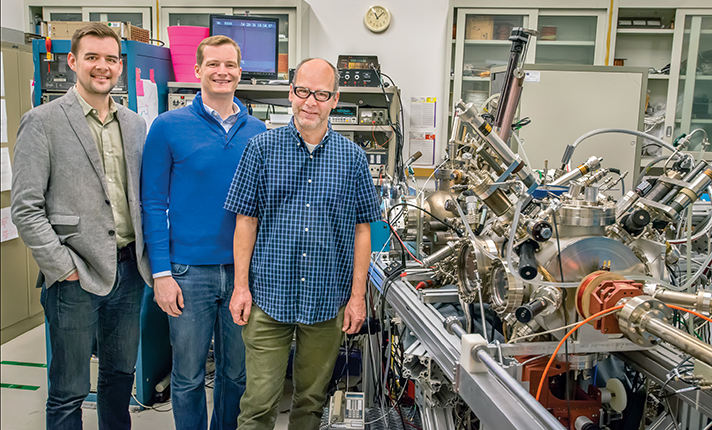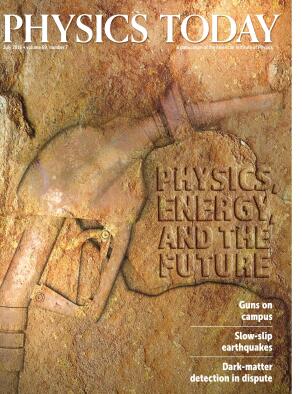National labs are nurturing clean-energy startups
DOI: 10.1063/PT.3.3231
Argonne National Laboratory’s launch of a new business incubator in May replicates an 18-month-old entity at Lawrence Berkeley National Laboratory that has attracted considerable interest from aspiring clean-energy-technology entrepreneurs. Argonne’s program, dubbed Chain Reaction Innovations, and Lawrence Berkeley’s Cyclotron Road aim to provide a small number of energy innovators with access to advanced tools and mentoring to help mature their technologies so they can attract early-stage investors.
Both programs are funded at $3 million by the US Department of Energy’s Office of Energy Efficiency and Renewable Energy (EERE), and Argonne is kicking in another $1 million for its program. Cyclotron Road, which began as a pilot supported by Lawrence Berkeley, in February chose its second cohort of nine scientists to work on six projects. They join the nine scientists and six projects that got under way in December 2014.
Besides technical assistance, the programs will help mentees develop business plans, create companies, and secure financing. “What we’re focusing on is talent development. We’re not funding R&D per se but supporting innovators,” says Mark Johnson, who heads EERE’s advanced manufacturing office. “You can think of it as an entrepreneurial postdoc experience.”
Innovators from academia usually have few options to further develop their technologies, Johnson notes. “They either needed to build a lab to be able to do what they need or [they needed to] have a prototype and get resources. They could continue to pursue things just on a pure science basis, but then can’t move to translate it to a product.”
Most innovators mistakenly focus on the science alone and fail to take the time to discern the needs in the marketplace, he says. “Some say, ‘I’ll just get a business student to work on this,’ and typically that’s not a successful route because they’re disconnected from the science.” Having a set of people who understand both science and business is essential, he notes.
The two labs are looking to team with an organization that could provide more comprehensive business mentorship than they can alone. But neither lab wants to make its partner organization the sole resource for the mentees; some may opt for their own advisers on commercial matters, says Suresh Sunderrajan, director of Argonne’s technology development and commercialization division. Clean Energy Trust, Energy Foundry, and Northwestern and Purdue Universities are examples of Chicago-area mentoring organizations.
Sunderrajan says Chain Reaction Innovations hopes to attract new PhDs or postdocs who want to carry on their research interests and who have a technology that “has legs.” Unlike in software development, where little more than a couple of laptops might be needed, physical sciences or energy-related technologies require “access to cutting-edge analytical equipment and an infrastructure that allows modeling, experiments, and building prototypes,” he notes.
Ilan Gur, director of Cyclotron Road, is a former program manager at DOE’s Advanced Research Projects Agency–Energy (ARPA–E). He has personal experience starting up two clean-energy materials companies using venture capital. One involved batteries and the other solar energy technology. In both cases, he says, the outcome would have been far better had he had access to a program like Cyclotron Road. “What I learned from that experience was that the technology when we stepped out of the lab wasn’t in a mature enough place to make sense to have [venture capital]. And yet there wasn’t any other option. If there were only some other place to go so that you could be smart about the investors you choose to take money from or not.”
Gur and Sunderrajan say the goal of the incubators is to “spin-in” technologies—contrary to the better-known spin-out route for inventions made at the labs. The grantees receive stipends so they can work on their missions full-time. Both labs make available a host of user facilities: high-performance computers, light sources, and nanoscience research centers, among others.
Cyclotron Road’s initial cohort has so far won $5 million in competitive grants—including two awards from ARPA–E, five Small Business Innovation Research awards, and one from the California Energy Commission. One of the teams has received some private backing, and it’s probable that another one or two will gain some initial investment before their stay at the lab ends, says Gur.
A space-age energy castoff
Among Cyclotron Road’s first cohort is Jared Schwede, who cofounded Spark Thermionics with fellow Stanford University alumnus Dan Riley to develop thermionic energy. Heat applied to one of two dissimilar materials that are separated by a vacuum causes electrons to flow from the hot electrode to the cooler one. Schwede says the technology has been largely moribund since the 1960s, when NASA selected a closely related technology, thermoelectrics, to power its deep space missions. Intrinsically the more efficient of the two, thermionics has benefited from advances that enable the mass fabrication of micron-scale vacuum gaps on silicon wafers. That development will improve energy efficiency from the 15% it was in the 1960s to 25% or more, he says.

Dan Riley and Jared Schwede (from left), cofounders of Spark Thermionics, and Lawrence Berkeley National Laboratory researcher Andreas Schmid stand beside a spin-polarized low-energy electron microscope that is being used in the development of a thermionic energy converter.
ROY KALTSCHMIDT/LAWRENCE BERKELEY NATIONAL LABORATORY

Teamed with researchers from other institutions, Spark Thermionics was recently awarded a $3.8 million ARPA–E grant. Schwede says that on completion of that two-year grant, the company will be close to marketing a kilowatt-scale thermionic power plant that will be more efficient than the diesel systems used in the developing world and in many off-grid locations.
“Doing this kind of development without Cyclotron Road would be very, very challenging,” Schwede says. “It’s highly applied and there are a lot of details about making sure a device works that are not interesting to publish. So that becomes much more difficult to do in an academic environment.”
At Lawrence Berkeley, Andreas Schmid operates a special-purpose electron microscope, one of only four or five in the world that produce a spin-polarized electron beam. The beam energy is low enough that the instrument can image the work function of the candidate materials for use in thermionic cells, he says. The microscope also is equipped with metal vapor sources that provide in situ application of coatings to be tested for use on the electrodes.
“This machine might as well have been purpose built for developing thermionic electricity,” says Schwede. “We didn’t even know it existed until we got into the program.”
Another Cyclotron Road project from the initial cohort involves developing an electrochemical process to convert carbon dioxide into useful products. Known as Opus 12, the project received funding from the Shell GameChanger program in February for a feasibility study of its process for using renewable energy to produce synthesis gas from CO2. The formation of the syngas, which is made up of hydrogen, carbon monoxide, and sometimes CO2, is a step toward the manufacture of methanol and other liquid fuels. Other first-generation projects at Lawrence Berkeley include wave energy, conversion of agricultural residues to chemicals and fuels, and identification of chemicals for advanced materials and additive manufacturing.
Among the second cohort of projects are solid-state and lithium–sulfur batteries, tandem solar cells combining conventional silicon and cadmium–tellurium technology with perovskite photovoltaics, and recyclable advanced composites. Gur says there is no shortage of ideas for clean-energy technologies: Within three weeks of its July 2014 opening, Cyclotron had received 150 applications. “The message is, There is nothing like this and this is exactly what [applicants] have been searching for,” he says. The interest continues unabated: Round two saw 200 people register for the six slots.
Expansion of the incubators to other DOE labs is possible, but, according to DOE’s Johnson, it will occur “at a measured pace.”
More about the Authors
David Kramer. dkramer@aip.org




